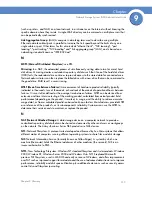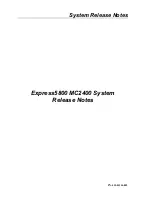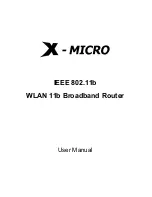
153
Chapter 9: Glossary
Network Storage System (NSS) Administrator Guide
Chapter
9
P
Parity:
A way to attach additional binary digits to data blocks that lets a NAS controller monitor if
data has been lost or overwritten after it has been moved from one place to another in a storage
array or among networked computers.
PSU:
Power Supply Unit. A device or system external to or within the NSS that supplies electrical
power to the device or group of devices.
R
RADIUS (Remote Authentication Dial-in User Service):
An authentication, authorization, and
accounting protocol to access a network locally or remotely. RADIUS uses a RADIUS server that
resides in the local network or as an offsite, leased resource/service to perform the authentication
and authorization functions.
RAID:
Redundant Array of Inexpensive or Independent Disks. In storage environments, a RAID uses
multiple physical disk drives to create a single logical unit from which data can be shared or
replicated between the drives. There are various RAID levels (or ways to define how the disks work
together). Each level provides one or more of increased data integrity, fault-tolerance, and
throughput or capacity. The types of RAID levels and combinations of these levels is constantly
changing as new methods and technologies continue to improve. Currently, the NSS offers the
choice of five different RAID levels (including JBOD) with two options for adding a hot spare to an
existing RAID level.
RPSU:
Redundant Power Supply Unit. A device, typically rack mountable, that provides instant
power should the power fail to a device (such as a network switch or NAS). Implementing an RPSU
in a network wiring closet provides a greater degree of availability for devices on the network.
S
SAN (Storage Area Network):
A network of storage and server devices typically found in large,
enterprise environments with high volume or high data traffic requirements. SANs are architected to
be scalable so that computer storage devices (such as disk array controllers, tape libraries, and
servers) can be added and incorporated into the system. A SAN lets computers connect to hard disk
drives and tape drives on a network as though they were locally attached devices. A SAN can
contain a NAS or numerous NAS devices.
SAS (Serial Attached SCSI):
A computer bus technology and serial communication protocol to
transfer data to and from hard disk drives and CD-ROMs. Used in large enterprise environments to
replace legacy, parallel, SCSI solutions, because SAS attains much higher transfer speeds, and has
backwards-compatibility with SATA. SAS uses serial communication to establish connectivity to other
SAS devices and uses SCSI commands for file transfer.
SATA:
Serial ATA. A computer bus technology that evolved from the Parallel ATA physical storage
interface. Like PATA, SATA is an IDE (Integrated Drive Electronics) drive, designed for transfer of
data to and from a hard disk. Serial ATA is a serial link -- a single cable with a minimum of four
wires creates a point-to-point connection between devices. Transfer rates for Serial ATA begin at
150 MBps. One of the main design advantages of Serial ATA is that the thinner serial cables
facilitate more efficient airflow inside a form factor and also allow for smaller chassis designs. The
















































